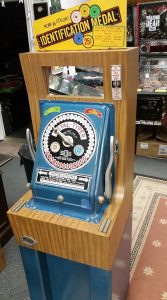In this installment, I take a break from pinball repair and work on an interesting old arcade device that is mostly mechanical. In addition to this, it’s a specific machine I remember from when I was in high school and worked at a local amusement park. This device was saved from being taken to the city dump and stored for 30 years until I found it. The challenge is, can it be made to function again? Let’s see!
 This is an interesting mechanical device that will take aluminum “tokens” and allow you to stamp your own messages on them. These were vary popular at carnivals and amusement parks and museums and arcades around the world. The tokens originally cost about 7 cents each, so for a quarter, the operator could make almost 3x his money. But now it’s hard to find the original blanks for under $1 each. Still, this is a very unique piece. These machines were made from the 1930s until the 1980s.
This is an interesting mechanical device that will take aluminum “tokens” and allow you to stamp your own messages on them. These were vary popular at carnivals and amusement parks and museums and arcades around the world. The tokens originally cost about 7 cents each, so for a quarter, the operator could make almost 3x his money. But now it’s hard to find the original blanks for under $1 each. Still, this is a very unique piece. These machines were made from the 1930s until the 1980s.
In this video, I basically have to “reverse-engineer” how the machine works because there is so little documentation on it. I only found one other video online showing the game’s basic operation, so I decided to document my progress with this, including the mistakes I made. This 8 part video series covers the trials and tribulations of getting the machine operational. When I picked it up, it had been sitting in storage for 30+ years. All the movements were seized. I wasn’t even sure if the machine was complete.
Someone who has been working on these machines wrote me about what they’ve learned, and I thought I might share it here:
Ive been on a hobbyist level fixing old pachinkos, digger cranes and metal typers, for about 40 years, i did what you did and learned by hands on.
I just love them, i watched your video and might suggest at some point adding a 9th covering some of the adjustments in the metal typers.
I saw you seemed a bit disappointed in the stamp quailty, im ADD and OCD and it drove me nuts,
I found that the hammer adjustment for too hard or soft has to be in the goldilocks zone and the little place on the hammer has to hit the key dead on and even,
Some filing even welding might be needed on the hammer strike pad.
Then the letters, while the keys are super hard they can rust that will of course ruin it but what i do is clean the the best i can solvent and rag,
I dont want to risk hurting the texture it embosses around the letter, so i got magnifier and a thin strand of copper wire almost like a stiff bristle hair and cleaned in each letter, the copper wire is soft and won’t do damage.
To look clean you would be surprized how much crud is empacted in them,
Then very lite wipe with gun oil, im thinking of trying synthetic clock oil.
As you also must have learned the machines have a few other adjustments,
Also when the hoppers would get low aluminum didnt have a lot of weight and at times a token would slide over/under the stamped token rather than pushing out to the person who printed it, big jam cauysed some machines to be trashed but wasnt hard to unjam,
A lead weight on the top of each hopper tube stack will pretty much fixes that.
Voltage depends on the solenoid but for example one of mine has a 12v solenoid, rather than use old dry cells i run a 9v with a large capacitor, it hits hard and works for a long time in my home,
2 6v lantern batteries will also work and sometimes a plug in 12v supply is used,
But i like the no plug idea.
